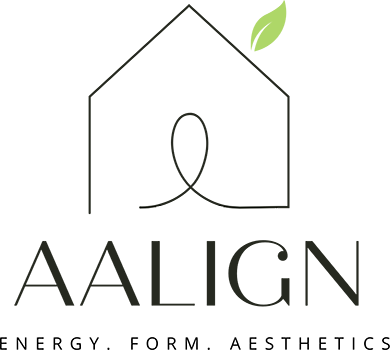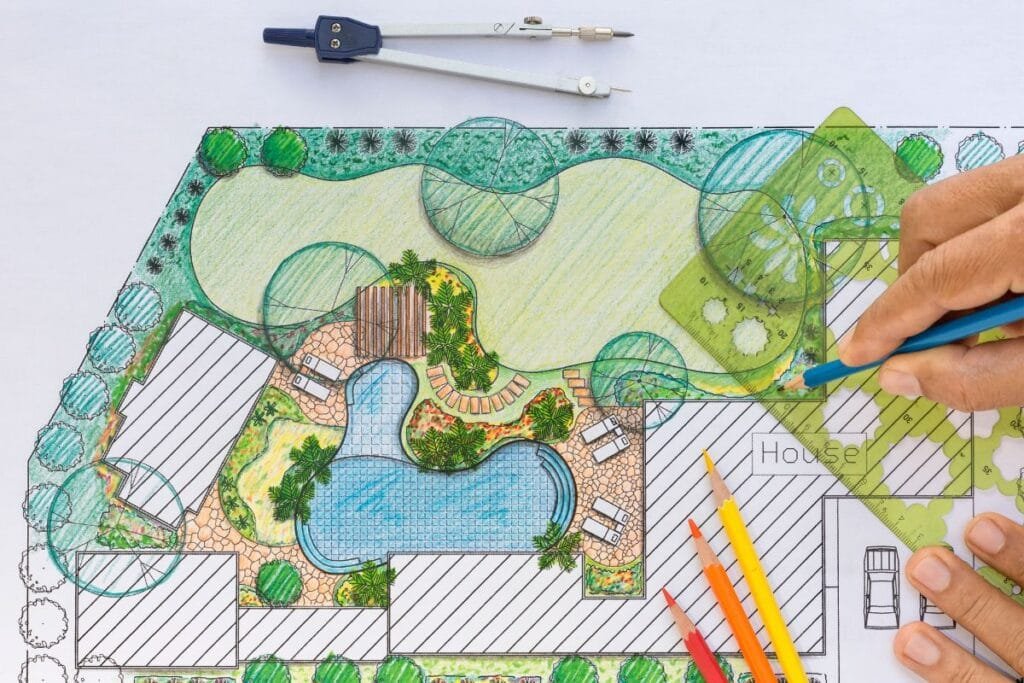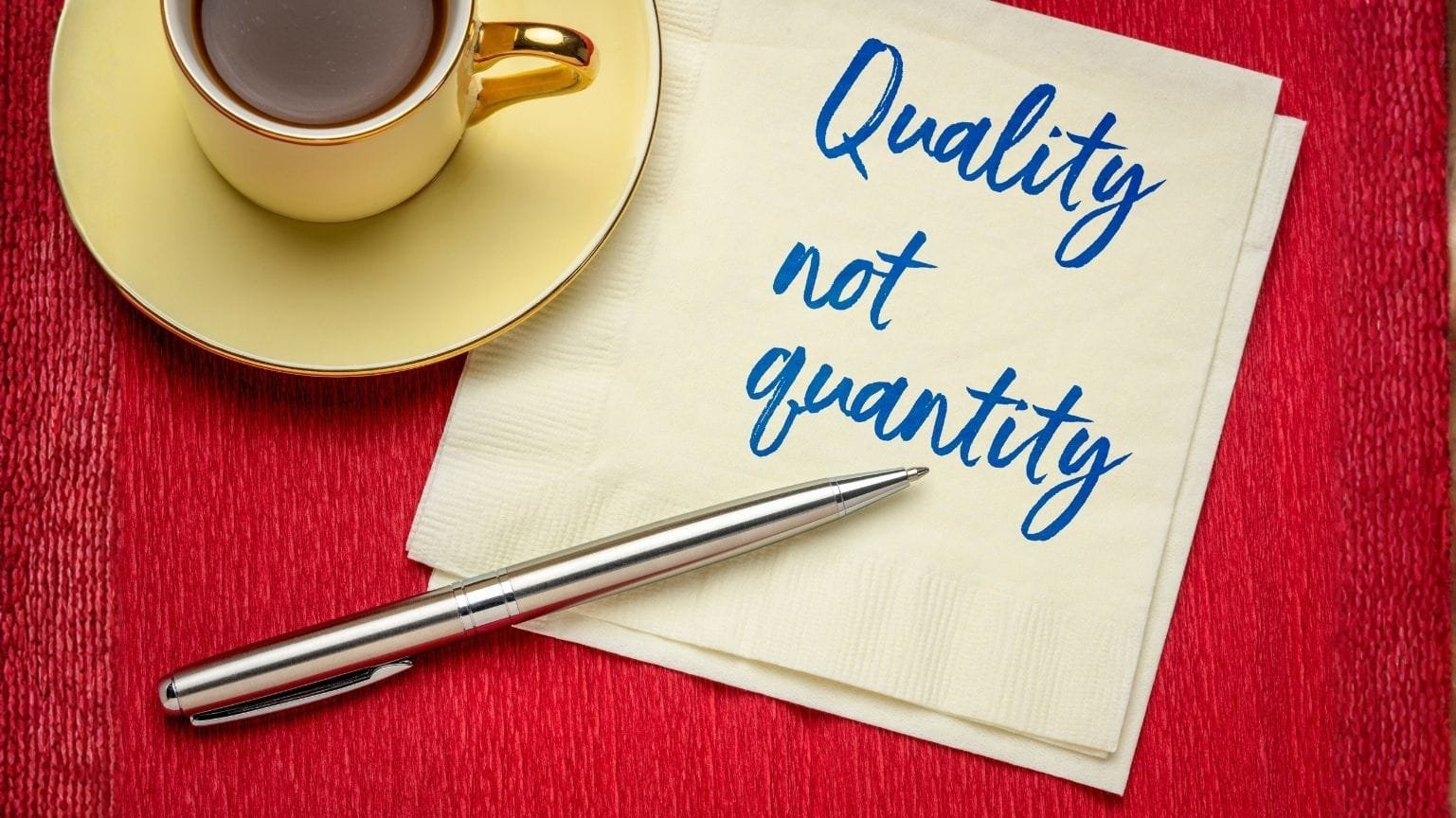Comfort, convenience, and money-saving are all benefits of wellness-conscious design! By focusing on healthy living spaces, you can create a home that supports your well-being. Think about natural light – it can boost your energy levels and even reduce your reliance on artificial lighting.
Even something as simple as building orientation can affect how a space feels and functions. However, it’s good to keep in mind that hidden toxins can turn up wherever you least expect them.
Flame retardants in furniture, formaldehyde in desks, and stain-resistant chemicals (PFA’s) in carpets harm your health. These chemicals disrupt hormones, hinder development, and even increase cancer risk with prolonged exposure.
Take advantage of these 13 effective ways to design peaceful and prosperous healthy living spaces! It outlines what you need to do, where to start, and what to consider when creating your oasis.
1. Location & Orientation Matters

Prior to hammering the first nail, think about what is truly going to add to or improve your quality of life when building a new home or renovating. It could be things like designing a cozy reading nook flooded with natural light, crafting a kitchen that invites laughter while sharing meals and stories. An office that sparks productivity or a bedroom that feels like a tranquil escape with a quiet meditation space.
Imagine a home gym that motivates your fitness journey, a tech-free zone for uninterrupted family game nights, or a front porch swing where you can unwind and connect with your neighbors.
Intentional design choices make your living space a canvas for experiences that enrich and define your everyday moments. In these thoughtful details, you’ll find the true essence of a home that nourishes not just the structure but also the spirit.
Don’t forget to keep your project in harmony with nature, including trees, plants, natural light, etc., for aesthetics and a sense of connection with its surroundings. Start with finding the optimal direction, as it can make a difference. Check out these tips to see what each direction has to offer:
Orientation:
In the Northern Hemisphere:
In the Northern Hemisphere, winter brings the most sunlight, favoring south-facing structures for maximum warmth and natural light due to the sun’s lower position.
In the Southern Hemisphere:
In the Southern Hemisphere, summer receives the most sunlight, making north-facing structures ideal for capturing direct sun exposure.
Advantages & Considerations for all Cardinal Directions
South-Facing Front Entry:
- Pros: Maximizes sunlight, enhances energy efficiency, ideal for solar gain.
- Cons: May require shading elements to control heat in warmer climates.
North-Facing Front Entry:
- Pros: Provides a consistent, cool temperature.
- Cons: Less direct sunlight, may require additional heating in colder climates.
East-Facing Front Entry:
- Pros: Welcomes morning sunlight, ideal for early natural light.
- Cons: May heat up faster in the morning, especially in warmer climates.
West-Facing Front Entry:
- Pros: Enjoys afternoon sunlight, suitable for evening activities.
- Cons: May require shading to prevent afternoon overheating.
2. Nature’s Elements to Consider That Affect Our Living spaces

- Sunlight: By regulating hormones and neurotransmitters, natural light profoundly impacts our energy levels, mood, and sleep patterns. It directly affects cortisol (linked with stress) and melatonin (essential for quality sleep) and much more. Thus, it’s vital to design spaces that allow abundant natural light for improved health.
- Shade: Consider shade when designing windows to optimize natural lighting and regulate heating and cooling efficiently within the living space.
- Views: Make scenic views a priority while balancing privacy concerns.
- Noise: Position your front door away from noisy streets or traffic.
- Landscape: Use the natural contours of the land to prevent flooding and erosion.
3. Insulation for Healthy homes and Buildings

A vital, yet often overlooked factor in a home or building is insulation. It helps maintain a healthy home environment by regulating temperature, reducing noise, and preventing mold growth through moisture control.
It fills stud cavities, prevents heat loss in attics and ceilings, keeps floors dry, dampens sound between floors, and safeguards against drafts in HVAC ducts and rim joists. This contributes significantly to comfort and energy efficiency. While the variety of options available can be overwhelming, choosing based on wellness and eco-friendliness can guide you.
Consider your health before picking insulation to avoid options that emit fumes or irritants, such as fiberglass. Material such as recycled materials or natural fibers is good for the environment. Healthy options may cost more initially, but they can save you money in the long run. Building professionals can help you choose the best insulation based on factors such as budget, climate, desired performance, and environmental concerns, depending on where you live.
- Traditional Spray Foam: This type of foam is versatile and effective, but contains polyurethane, a harmful substance that emits harmful VOCs during and after installation. Its environmental footprint is also substantial. The downside of traditional spray foam insulation is that VOCs released irritate the respiratory system, cause headaches and contribute to other health problems.
- Traditional Spray Foam: This type of foam is versatile and effective, but contains polyurethane, a harmful substance that emits harmful VOCs during and after installation. Its environmental footprint is also substantial. The downside of traditional spray foam insulation is that VOCs released irritate the respiratory system, cause headaches and contribute to other health problems.
How Traditional Spray Foam Insulation Pollutes the Environment?
- Manufacturing: Produces greenhouse gases and consumes energy.
- Harmful chemicals: VOCs contribute to air pollution and harm human health.
- Off-gas: VOCs remain in the air for years after installation, affecting indoor air quality.
- Disposal: Difficult to recycle, often ends up in landfills and polluting the soil furthermore.
Overall, its production, use, and disposal contribute to pollution, climate change, and health risks.
- Fiberglass: Although affordable, it can irritate skin and release dust particles, potentially triggering allergies and respiratory issues.
- Mineral Wool: A better alternative to fiberglass, it offers better fire resistance and less irritation. Research carefully since some variations might contain synthetic binders.
- Natural Fibers: Sheep’s wool, recycled cotton, and hemp excel in breathability and natural pest resistance. Costs and installation requirements may be higher.
- Soy-based Spray Foam: A greener alternative to traditional foam, however availability and performance can vary.
- Aerogel: Though expensive, it has excellent R-value and is lightweight. Currently, however, specialized installation and limited availability limit their use.
- Cellulose: Made from recycled paper, it’s readily available and cost-effective. For proper installation and long-term effectiveness, moisture management is crucial.
- Hempcrete: Highly insulating and fire-resistant, making it an ideal choice for earthquake zones. The material is lightweight and versatile, made of hemp fibers, lime, and water. Besides providing thermal insulation, it also captures and stores carbon dioxide, adding to its already impressive eco-friendliness. Hemcrete absorbs moisture more readily in areas with high humidity or potential water exposure (e.g., basements and crawl spaces).
4. Tankless Water Heater & Geothermal Heat Pumps

Tankless Water Heater
On-demand water heaters, also known as tankless water heaters, heat water directly without using a storage tank. The unit heats water only as it flows through, supplying hot water continuously. The benefits include:
- On-demand water heaters, or tankless water heaters, heat water directly without a storage tank. The unit continuously heats water as it flows through it. Because they only heat water when needed, they reduce energy consumption and avoid energy losses associated with storing hot water in tanks. Even though the upfront costs are higher, energy savings offset these costs over time. Additionally, tankless water heaters have a longer lifespan, which means less waste, lower replacement costs, and lower utility bills and maintenance expenses.
Geothermal heat pumps (GHPs)
GHP’s are a type of heating and cooling system that utilizes the Earth’s constant underground temperature to heat and cool your home. GHPs are a fantastic alternative to traditional heating and cooling systems, because the following makes them more efficient:
- The system harnesses the Earth’s natural heat, reducing fossil fuel consumption and greenhouse gas emissions.
- Unlike traditional heating/cooling systems, GHPs offer year-round comfort with quiet operation and even temperature distribution.
- They last 20-25 years, nearly twice as long as conventional systems.
Generally speaking, it is slightly more expensive than conventional systems, requires professional installation, and may disrupt your yard if not a new construction.
5. Solar Tubes & Backyard Wind Turbine
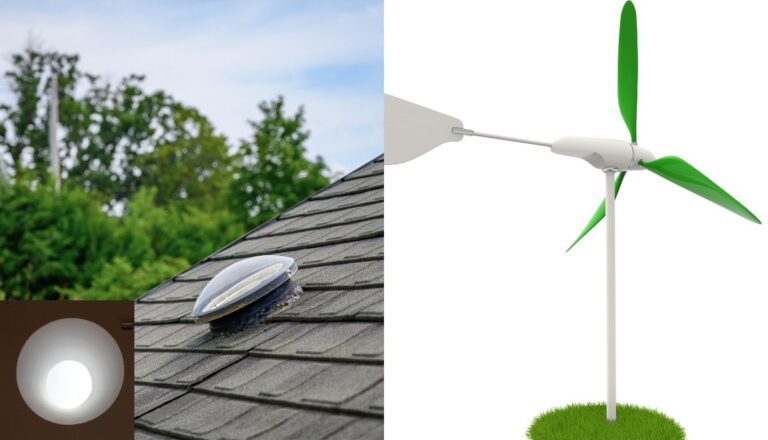
Solar Tube
Known as a sun tunnel or light tube, a solar tube captures natural sunlight from the roof and funnels it through a highly reflective tube into interior spaces. Solar tubes are an asset to healthy living, sustainable homes, and cost savings:
- The natural light they produce enhances mood and productivity, along with a plethora of health benefits related to full-spectrum light exposure.
- Solar tubes reduce the need for artificial lighting during the day by harnessing renewable solar energy.
- Once installed, they require minimal maintenance, reducing long-term costs associated with electric lighting.
Backyard Turbine
Small-scale wind turbines are designed to harness the power of the wind to generate electricity for residential use. Smaller than commercial wind turbines, they can be installed in residential backyards and contribute to cost savings, sustainable homes, and eco-friendliness in a variety of ways:
- By offsetting a portion of home electricity needs, they lower utility bills and reduce long-term costs and provide tax incentives.
- Clean energy from the wind reduces greenhouse gas emissions.
Their renewable energy sources reduce reliance on traditional power sources. - When there is abundant wind power, it can be an effective alternative to solar power.
6. Upgrade Windows

Take advantage of dual-paned windows that are properly sealed and are very effective in reducing energy waste. Or you can enhance insulation by installing windows with low-emissivity coatings (Low-E), ensuring a comfortable indoor temperature and minimizing energy costs.
The benefits of investing in such windows outweigh the initial costs, and rebates are often available.
7. Indoor Air Quality: The Foundation of Healthy Living Spaces

Installing Indoor Air Quality (IAQ) monitors, these devices measure moisture, volatile organic compounds (VOCs), mold, radon, and other particulates, helping homeowners improve their indoor air quality.
Moreover, they alert homeowners when a healthy environment is disrupted, so that timely action can be taken. Additionally, consider small things like natural ventilation to enhance indoor air quality.
(Tip: investing in an indoor air quality test (around $400) can be beneficial before you move in, as it identifies hazardous materials both pre and post construction, including substances like asbestos, VOCs, and mold).
8. Wall Paints, Coverings & Finishes

For wall coverings, choose non toxic sustainable materials and finishes that does’t harm indoor air quality such as:
- Low VOC Paints: To minimize indoor air pollution, choose low or zero VOC (Volatile Organic Compounds) paints. Steer clear of lead-based paints to protect against lead exposure, especially for children.
- Wallpapers: Choose wallpapers with low or zero VOCs to minimize off-gassing and improve air quality. Innovative wallpapers made from bamboo or recycled fibers are also available today.
- Natural Fiber Wall Coverings: As natural and renewable fibers, jute, hemp, and sisal are exquisite wall coverings that offer a unique ambiance and a sense of connection to nature. Beyond their aesthetic appeal, these materials are non-toxic and biodegradable.
- Clay plaster: A trending and eco-friendly alternative, clay plaster has become a popular choice for both interior and exterior applications because of its health benefits, eco-friendliness, and versatility. Clay plaster’s natural and textured look has made it a popular choice for modern home designs. It is a fire-resistant, moisture-regulating material made from natural clay and sand that improves indoor air quality.
- Recycled bricks in modern design are a unique choice for interior walls and floors. Bricks not only add character and sustainability to interior spaces, but also add a cozy feel by seamlessly blending aesthetics and functionality.
- Wood Paneling: An attractive look for walls can be achieved with wood paneling. Look for wall coverings made of recycled and sustainably sourced wood. It not only adds character to the space, but also reduces the demand for new timber, thereby preventing deforestation.
- Cork Wall Tiles: Cork wall tiles provide an attractive texture, create a distinctive look, and provide natural insulation to walls. They are also mold and mildew resistant.
- Living Walls or Vertical Gardens: Last but not least, don’t overlook this option as a eco-friendly and aesthetically pleasing wall covering. Air quality and thermal regulation are improved with these installations.
9. Flooring
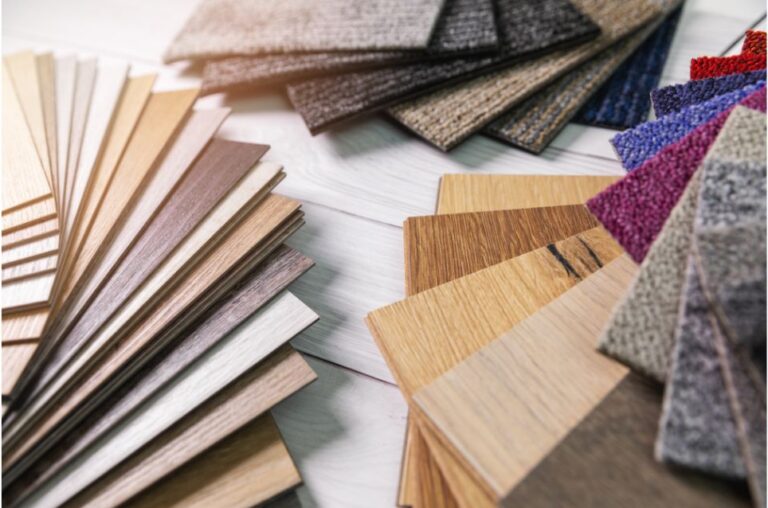
Choosing wood floors for a healthy home environment involves considering both the type of wood and the finishing materials. Here’s a breakdown to help you make informed decisions:
Wood Types:
Solid Hardwood or Softwood: These are classic choices that typically emit low levels of chemicals. Popular options include oak, maple, cherry, pine, and cedar. It is best to select wood with low VOC finishes, and certified products such as FloorScore or GreenGuard, to minimize off-gassing. Softwood: Examples are pine and cedar.
Engineered Wood: With this option, you get a real wood veneer on top of a composite core. Look for products that are CARB Phase 2 certified (California Air Resources Board) or have similar low-emission standards, like FloorScore or GreenGuard. Older engineered wood may contain formaldehyde, a potential carcinogen. Composite wood flooring such as laminate or luxury vinyl plank, also fall under this category. It’s a type of engineered wood where the core is primarily made from compressed wood particles with resin and other additives.
Reclaimed Wood: This eco-friendly choice adds character to your space. Make sure the wood has been treated properly to address potential allergens and contaminants accumulated over time, and that it is FSC-certified.
(If specific product information is available, check the EPH for detailed chemical composition and potential emissions)
Note: Composite wood, while it offers advantages like strength and affordability, health concerns arise from the resins and adhesives used. In older installations, these elements may emit formaldehyde, a VOC that can cause respiratory irritation and cancer. Furthermore, some composite wood might release other VOCs with unknown health effects. Prioritize low-emission composite wood with CARB Phase 2 certification to minimize risk.
High:
- Engineered wood: Glues often contain formaldehyde, a carcinogen.
- Laminate: Glues and resins release VOCs linked to respiratory issues.
- Pre-finished solid wood: May have VOC-laden finishes.
Moderate:
- Unfinished solid wood: Untreated, but sanding/finishing releases dust and VOCs.
- Unfinished solid wood: Untreated, but sanding/finishing releases dust and VOCs.
Low:
- Solid wood finished with natural oils/waxes: Minimal emissions.
- Reclaimed Wood: Has already aged and off-gassed most toxins.
- Solid wood itself is safe, but finishing processes can use VOCs and formaldehyde. There are low-VOC alternatives, such as formaldehyde-free glues and natural oil/wax finishes etc., to minimize exposure. Nevertheless, exposure levels can vary based on factors such as ventilation, duration, individual sensitivities, and the specific products used.
- Go for Solid wood as engineered wood can emit VOCs unless specified.
- FSC-Certified (ensues responsible wood sourcing) Solid Hardwood or Zero-VOC Engineered Wood: Look for brands like Cali Bamboo and Teragren for high-quality options.
- Go for Solid wood as engineered wood can emit VOCs unless specified.
- Low-VOC finishes: Look for finishes certified by Greenguard
- Low-VOC finishes: Look for finishes certified by Greenguard
- Minimal adhesives: Choose click-lock or pre-finished options.
- Minimal adhesives: Choose click-lock or pre-finished options.
- Bamboo Flooring:With its rapid regeneration, minimal environmental impact, strength, and durability, bamboo is a great flooring option that is durable, eco-friendly, and resistant to moisture.
- Bamboo Flooring:With its rapid regeneration, minimal environmental impact, strength, and durability, bamboo is a great flooring option that is durable, eco-friendly, and resistant to moisture.
- Cork Flooring: Cork is antimicrobial, comfortable to walk on, and sustainable. Cork is also a natural thermal and acoustic insulator. USFloors and Wicanders offer cork flooring options.
- Cork Flooring: Cork is antimicrobial, comfortable to walk on, and sustainable. Cork is also a natural thermal and acoustic insulator. USFloors and Wicanders offer cork flooring options.
- Reclaimed Wood Flooring: Look into reclaimed wood flooring for a unique and rustic vibe. Brands like Elmwood Reclaimed Timber provide high-quality flooring options.
Below is a list of flooring options ranked from the most eco-friendly and non-toxic to the least. Additionally, consider installation and maintenance practices as well.
Cork Flooring:
Natural cork flooring is typically made with no chemicals or adhesives, making it a healthy and environmentally friendly option.
Linoleum Flooring:
As a result of its natural ingredients such as linseed oil, cork dust, and wood flour, linoleum is considered to be both eco-friendly and non-toxic and is often chemical-free.
Bamboo Flooring:
Bamboo flooring is an eco-friendly alternative to hardwood flooring, made from a fast-growing, renewable grass. It’s often manufactured without toxic chemicals and adhesives.
Marmoleum Flooring:
Marmoleum, made of linseed oil, jute, and cork dust, is a natural and nontoxic flooring option renowned for its fire resistance, environmental friendliness, sustainability, and ease of cleaning.
Hardwood Flooring (FSC-certified or reclaimed):
A solid wood floor derived from sustainably managed forests (FSC-certified) or reclaimed material can be both non-toxic and eco-friendly, especially when sealed with natural oils or low-VOC sealants.
Engineered Wood Flooring:
While not as eco-friendly as solid hardwood, some engineered wood flooring is made with low-VOC adhesives and finishes, offering a non-toxic option.
Natural Stone (e.g., slate, granite, limestone):
Natural stone is durable and non-toxic, however, its extraction and transportation can affect its eco-friendliness.
Good to Know: Stone Flooring Certifications
The Marble Institute of America (MIA) certifies the quality and sustainability of natural stone products.
The NSF International Certified Sustainable Granite and Marble Program assesses the environmental and social impacts of the quarrying and processing of granite and marble.
Porcelain Tile:
Made from natural clay, porcelain tiles are non-toxic.
Ceramic Tiles:
Tiles made from clay and other natural materials are generally less dense than porcelain tiles, but they can still be used for walls and floors.
Concrete (recycled or from local sources):
The use of recycled or local concrete can be a sustainable option for flooring. Although it provides a solid, non-toxic surface, it does have a negative environmental impact due to sourcing and transportation.
Luxury Vinyl Tile (low-VOC, phthalate-free):
Low-VOC luxury vinyl tiles (LVT) are relatively eco-friendly options within the vinyl category. Nevertheless, it is important to consider its overall environmental impact, especially in terms of recyclability.
Laminate (low-VOC):
Choosing laminate flooring with low-VOC properties can help to create a healthier indoor environment.
Vinyl Flooring:
There are concerns about off-gassing of harmful chemicals from vinyl flooring, despite its affordability. While low-VOC options do exist, they are less preferred than the above alternatives due to their overall environmental impact and long-term health implications.
CARPET
Carpets & Rugs made of Natural Materials:
- Wool: Made from sheep or lamb fleece.
- Cotton: Made from natural cotton fibers.
- Sisal: Made from the agave plant.
- Jute: Made from the Jute plant.
- Seagrass: Made from natural seagrass fibers.
Synthetic:
- Nylon: A synthetic polymer made from petrochemicals like coal, water, and air.
- Polyester: A synthetic material derived from petroleum-based chemicals.
- Polypropylene (Olefin): A thermoplastic polymer made from propylene gas.
- Acrylic: A synthetic fiber made from acrylonitrile and a monomer.
In general, synthetic carpets emit the most VOCs, while natural materials like wool and cotton emit the least (level varies depending on treatment with cotton). Seagrass, jute, and sisal also being natural fibers have minimal chemical treatments and considered great non-toxic choices.
Biodegradable options like wool or sisal decompose naturally at the end of their lifespan, releasing nutrients back into the soil. In contrast, manufacturing and disposal of synthetics typically creates environmental and health burdens due to their reliance on fossil fuels and slow decomposition rates.
Padding & Adhesives Used For Carpet & Area Rugs:
When selecting padding and adhesives, natural alternatives can mitigate toxicity. Here’s a streamlined guide.
Padding:
- Natural Rubber: Offers excellent cushioning, hypoallergenic properties, and resistance to mold and mildew. Choose recycled rubber for sustainability.
- Wool: Provides luxurious comfort and insulation; opt for organic wool to avoid chemical treatments.
- Cork: Recyclable, eco-friendly, offers bounce and noise reduction, but is slightly firm.
- Recycled felt: Made from post-consumer materials, it provides cushioning and noise absorption. Make sure it is dye-free and chemical-free.
- Natural Rubber: Offers excellent cushioning, hypoallergenic properties, and resistance to mold and mildew. Choose recycled rubber for sustainability.
Adhesives:
- Natural Rubber Adhesives: Very low VOC formulations and strong bonding properties.
- Carpet Tape: A double-sided tape with a rubber or acrylic adhesive suitable for various types of rugs and floors.
- Gripper Dots: Natural rubber or felt adhesive dots for effective grip, especially on hard floors.
- Natural Rubber Adhesives: Very low VOC formulations and strong bonding properties.
In terms of cost, wool is the most expensive carpet material, known for its luxurious feel and natural properties. Following closely, nylon is moderately priced due to its durability and stain resistance. Polyester is a budget-friendly option, providing stain resistance at a lower cost. Polypropylene (Olefin) is the least expensive due to its moisture-resistant properties, but remember, as the cost decreases, the toxicity may increase in most cases.
It’s important to weigh the effectiveness of protective carpet coatings against their potential downsides, so consider either eliminating them or using natural alternatives instead.
- Synthetic Coatings:
Pros: Resists water, stains, and mildew, extending carpet life and simplifying cleaning.
Cons: These coatings emit harmful fumes that can cause health concerns, so choose low-VOC and VOC-free options with adequate ventilation. Over time, effectiveness may diminish, requiring reapplication, and certain treatments may make carpets slippery, increasing the risk of falls.
Examples: Scotchgard Carpet & Rug Protector, 3M Fabric Protector, Teflon Advanced Carpet Protector.
- Natural Coatings:
Pros: Considered safer for health and the environment, more breathable, and less likely to trap allergens.
Cons: The repellent properties of natural oils may not be as strong as those of synthetic oils, requiring more frequent reapplication. They may not be completely waterproof and may not repel all types of stains. Examples: Beeswax, lanolin, wool fat-based sprays.
In selecting floors, certifications and labels provide valuable information. Here are a few to consider:
- FloorScore® Certification: Ensures minimal chemical emissions in hard surface flooring.
- GREENGUARD® Certification: Guarantees low chemical emissions in flooring, available in Standard and Gold levels.
- LEED v4.1 Certification: Recognizes the use of FSC-certified wood in green buildings.
- Eco-Friendly Certifications: Look for certifications from reputable organizations like FSC or Green Seal.
- CRI Green Label Plus: Tests carpets for formaldehyde and VOC emissions.
- EPD of Wool Carpet Organization (WCO): Provides insight into the environmental impact of wool carpet across its lifecycle.
10. Energy-Efficient Appliances & Water-Efficient Fixtures
Invest in high-efficiency refrigerators, washing machines, and air conditioners with Energy Star ratings to reduce electricity bills. This can dramatically reduce water usage and conserve this precious resource.
Installing low-flow shower heads, faucet aerators, and more efficient toilets will help save money. WaterSense-labeled fixtures, for example, offer both water conservation and cost savings.
11. EMF & Dirty Electricity

An Easy Guide to Understanding EMF and Dirty Electricity
Given the ongoing uncertainty surrounding health risks linked to EMF exposure and dirty electricity, learning what it is, how it affects us, and where it comes from is advisable.
The understanding of side effects may unfold gradually; however, just as we became aware of harmful ingredients, additives, preservatives, hormones, etc., being added to our food over time, it’s wise to be cautious until more definitive facts are established.
Let’s dive into their sources and simple ways to mitigate them.
EMF Sources:
- Power lines
- Wireless routers
- Cell phone towers
- Household appliances (microwaves, ovens, refrigerators, etc.)
- Smart meters
- Baby monitors
- Bluetooth devices
- Electric cars
Dirty Electricity Sources:
- Computers and laptops
- Televisions and other entertainment systems
- Variable-speed motors (e.g., in some appliances and HVAC systems)
- Switch-mode power supplies (found in many electronic devices)
- Uninterruptible Power Supplies (UPS)
- Certain types of energy-efficient appliances
- Some types of chargers and power adapters
(Among others, these devices can make your home’s electricity messy by adding extra noise and vibrations. Using special filters and devices can help clean up this dirty electricity, making your home’s power work better).
*Differentiating Dirty Electricity from EMFs:
Dirty electricity is caused by unexpected surges in standard electricity, usually caused by modern devices. EMFs cover a wide range of energy fields produced by anything that uses electricity or magnetism.
Potential Health Concerns associated with EMFs and dirty electricity:
The following list includes some of the health concerns that have been noted. Despite the lack of solid evidence, their negative effects can and should be mitigated to create a calmer, healthier environment.
EMFs (Electromagnetic Fields):
- Disruption of the body’s biological processes
- Impact on sleep quality
- Adverse effects on the nervous system
- Infertility and reproductive issues
- Developmental effects in children
Dirty Electricity:
- Increased risk of various cancers
- Disruption of biological processes
- Adverse impact on overall health and well-being
- Aggravation of electrical sensitivity symptoms
- Potential links to cardiovascular disease
Some Ways To Mitigate:
Reduce EMFs:
- Shielding: Use EMF-shielded fabrics or paints, EMF shielding blankets, EMF meters.
- Distance: Increase the distance between yourself and EMF sources.
- Wired connections: Opt for wired internet over Wi-Fi.
Reduce Dirty Electricity:
- Filters: Install powerline filters on specific circuits or your entire home.
- Surge protectors: Use high-quality surge protectors for electronics.
- Choose wisely: Select appliances with lower dirty electricity emissions.
- Dirty electricity filters.
12. Thoughtful Selection of Furniture & Bedding
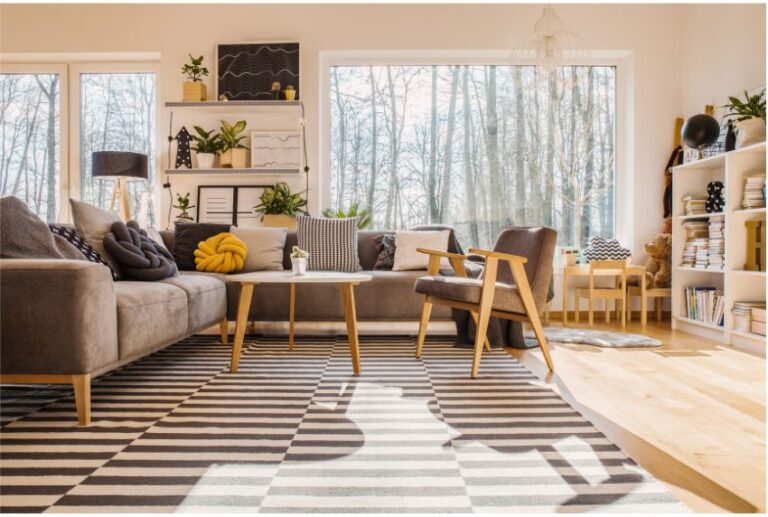
Creating non-toxic spaces is neither difficult nor complicated. It may not be possible and even unrealistic to completely eliminate toxic substances from your environment, so don’t get overwhelmed. Instead, simply make informed choices, reduce exposure to harmful chemicals, prioritize the use of natural materials.
All this can significantly improve your indoor environment. Creating a non-toxic living environment requires awareness of chemicals in furniture and bedding.
Why bedding? Because we spend a substantial amount of our day resting our bodies and minds, that environment, above all, needs to be the healthiest and non-toxic.
What Chemicals To Avoid In Furniture?
- Flame Retardants: are linked to health issues like endocrine disruption and cancer. Look for alternatives like wool or natural fibers treated with safer options like boric acid. Avoid furniture with labels like “TB-117” or “Tris“.
- Formaldehyde: A volatile organic compound (VOC) linked to respiratory irritation and cancer risks. Avoid furniture made of pressed wood like MDF or particleboard. Choose solid wood, certified low-VOC options, or natural materials like bamboo.
- PFAS (Per- and Polyfluoroalkyl Substances): Used for stain and water resistance, but linked to immune system and developmental issues. Avoid furniture and bedding with stain-resistant finishes. Choose untreated natural materials or water-based, PFAS-free alternatives.
- Isocyanates: Isocyanates, found in furniture adhesives and foams, can trigger respiratory issues and allergies. Opt for furniture with low-emission adhesives (like soy-based) or natural glues to minimize exposure. Consider latex alternatives for mattresses and cushions if you have concerns about isocyanates or latex allergies.
- Heavy Metals: Certain paints and finishes contain heavy metals that can accumulate in the body and cause health problems. Choose furniture with lead-free paints and finishes, and avoid metal frames with unknown compositions.
MATTRESS
- Synthetic Latex: Avoid synthetic latex containing harsh chemicals like benzene or styrene. Look for natural Dunlop latex certified by GOLS (Global Organic Latex Standard) or Oeko-Tex Standard 100.
- Memory Foam: Often contains VOCs and fire retardants. Consider alternatives, such as Talalay latex and wool, that are certified low-VOC.
- Polyurethane Foam: Similar concerns to memory foam. When possible, choose certified low-VOC options or natural alternatives like wool or plant-based foams.
- Flame Retardants: Linked to a variety of health risks. You can find safer alternatives like wool or natural fibers treated with boric acid. Avoid labels like “TB-117” or “Tris.”
- Formaldehyde: A VOC that can cause respiratory irritation and possibly cancer. A mattress made with pressed wood, such as particleboard or MDF, should be avoided. Consider solid wood frames and certified low-VOC options.
- Innerspring: Choose coils made with recycled steel or certified low-VOC materials.
- Coconut Coir: A sustainable and naturally flame-resistant option.
- Solid Latex: Naturally hypoallergenic and antimicrobial, look for GOLS-certified organic options.
- Organic Wool: Naturally breathable and fire-resistant, certified organic options are ideal.
- Natural Talalay Latex: GOLS-certified for low VOCs and known for pressure relief.
- Plant-Based Foams: Look for certifications like Oeko-Tex Standard 100 or Cradle to Cradle for sustainability and low emissions.
- Certifications: Look for Greenguard Gold, Oeko-Tex Standard 100, GOLS, or FSC certifications ensuring low VOC and sustainable sourcing.
- Transparency: Select manufacturers whose materials and certifications are readily available.
- Off-Gasing: Air out new mattresses in a well-ventilated space for several days before using.
- Second-Hand: Consider used mattresses made of natural materials without chemicals.
13. Be Aware of the Timely Release of VOCs
Paints emit VOCs during the painting process and can continue to off-gas for a extended period after application. Using low-VOC or zero-VOC paints will reduce this impact. Oil-based paints release VOCs for longer periods than other types of paint.
Estimated Off-Gasing Times:
Best case: In ideal conditions with good ventilation and a low-VOC content paint, off-gasing might subside within days to weeks.
Average case: For regular paint under typical conditions, expect off-gasing to last weeks to months.
Worst case: Oil-based paint in poorly ventilated spaces can emit VOCs for months or even years.
Adhesives and finishes used in flooring installation, particularly laminate and engineered wood flooring, can release VOCs. To reduce emissions, choose flooring materials with low or no VOC content.
Estimated Off-Gasing Times for Flooring Installation
- Solid Hardwood: Best case: days to weeks, Average: weeks to months, Worst case: unlikely, minimal natural emissions.
- Engineered Wood: Best case: weeks to months, Average: months to a year, Worst case: longer if high-VOC adhesives/finishes used.
- Tile (Ceramic/Porcelain): Best case: days to weeks, Average: up to a month, Worst case: unlikely, minimal off-gasing after installation.
- Stone: Best case: days to weeks, Average: up to a month, Worst case: unlikely, minimal off-gasing after installation.
- Laminate: Best case: weeks to months, Average: months to a year, Worst case: longer if high-VOC adhesives/underlayment used.
- Vinyl: Best case: weeks to months, Average: months to a year, Worst case: potentially years for higher-VOC options.
- Bamboo: Best case: weeks to months, Average: months to a year, Worst case: longer if non-carbonized bamboo or high-VOC adhesives used.
- Cork: Best case: days to weeks, Average: up to a month, Worst case: unlikely, natural material with minimal off-gasing.
- Solid Hardwood: Best case: days to weeks, Average: weeks to months, Worst case: unlikely, minimal natural emissions.
NOTE: These are estimates and can vary depending on ventilation, material quality, installation methods, temperature, and humidity.
Cabinetry and furniture construction can emit VOCs from adhesives and finishes. Choosing a product that is formaldehyde-free or low-VOC will reduce emissions.
Synthetic materials and adhesives in new carpets can release volatile organic compounds. VOCs are emitted during carpet installation. Choose carpets with low emissions or allow adequate off-gassing time before moving in.
Renovations and Demolition
As a result of renovations and demolition, various building materials can release volatile organic compounds (VOCs).
- VOCs are also released during drywall installation, cutting, and sanding.
- Using low-VOC or formaldehyde-free alternatives can help mitigate this problem.
As a result of renovations and demolition, various building materials can release volatile organic compounds (VOCs).
- VOCs are also released during drywall installation, cutting, and sanding.
- Using low-VOC or formaldehyde-free alternatives can help mitigate this problem.
Maintenance: The Key to Long-lasting Health
Nurture Your Space! Regularly clean appliances, carpets, HVAC systems, and filters. Utilize natural cleaning agents like peroxide, baking soda, and vinegar. Keep your space clutter-free for a more organized lifestyle.
Point Of Aligment
“What is good for us is also good for the planet”
Creating a healthy space is a thoughtful, multifaceted process. Utilizing non-toxic materials, maximizing natural light, and embracing sustainable practices can contribute to our well-being and vitality.
The cost may be higher currently due to lower demand, but once we start demanding non-toxic products that don’t pollute our soil, water, and air, we’ll drive up the supply and make them a norm and less expensive. Each small step we take will contribute to a healthier, happier living environment!
